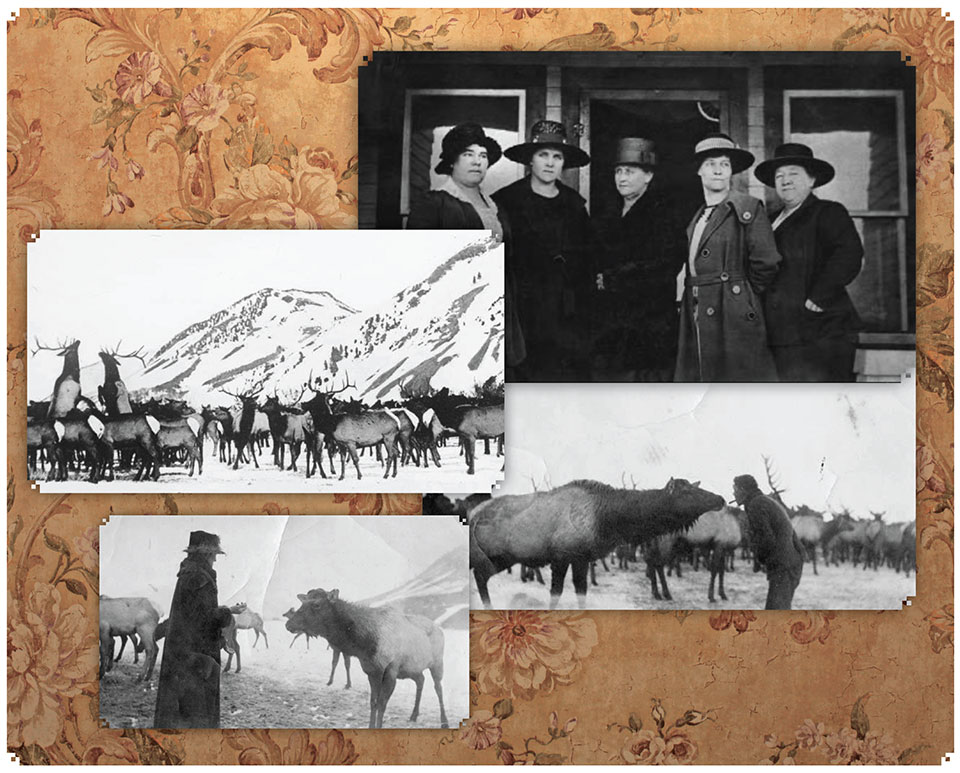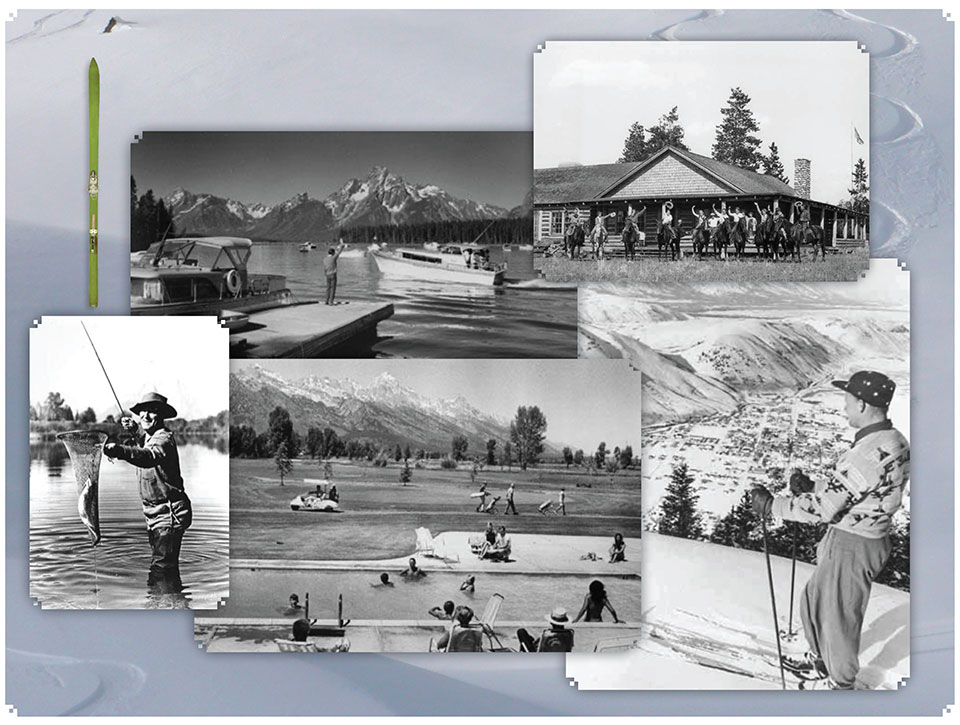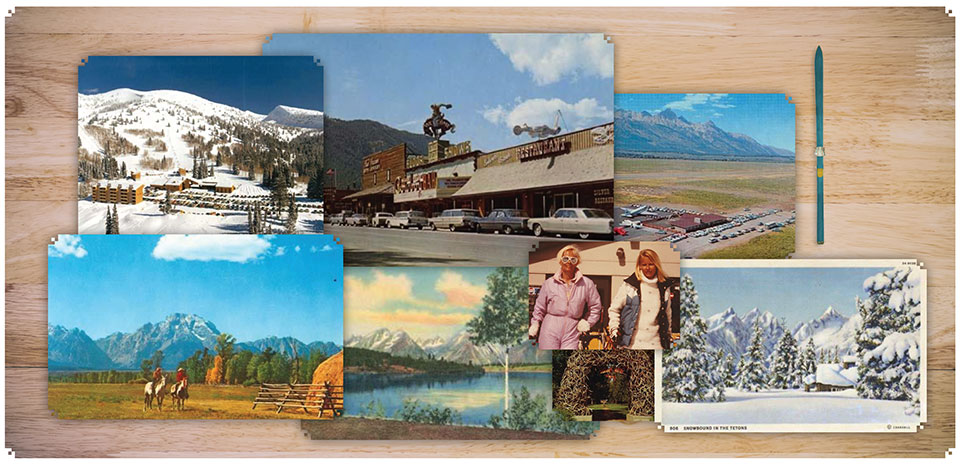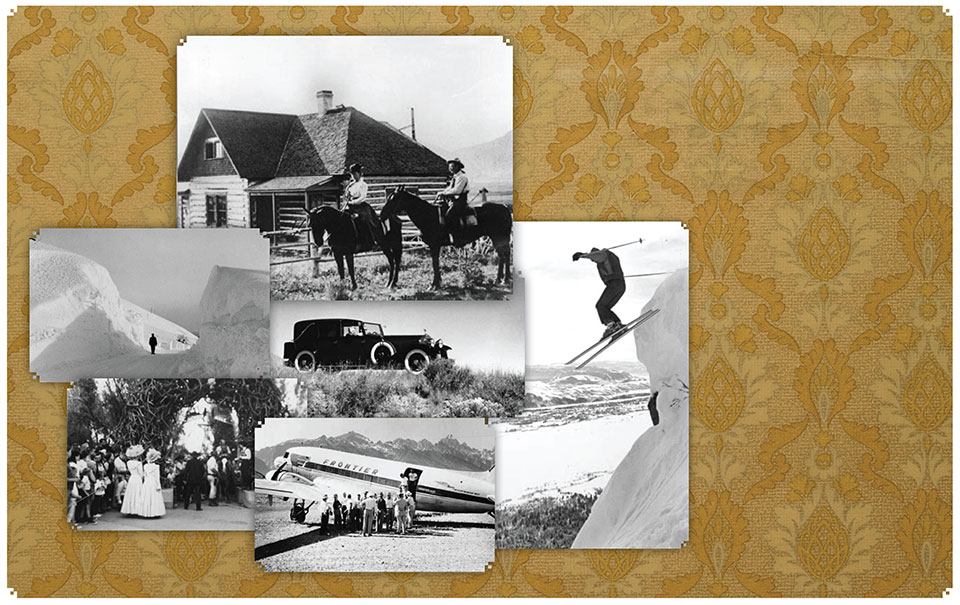Jackson’s Rugged-to-Refined History
MOUNTAIN MEN and WOMEN
by Cassidy mantor
photos courtesy Wyoming State Archives
In the winter of 1807, explorer John Colter set out from Three Forks, Montana, with 20 beaver traps and two other trappers as the Lewis & Clark Expedition made its way back east. History reveals that Colter and the other two explorers had a falling out two months into their expedition. Alone, Colter ventured into the wilderness that would become Yellowstone National Park and the Tetons. He spent the winter there trapping and is credited as the first modern mountain man. John Hoback, another Lewis & Clark explorer, also toured the area on his own. Subsequent trappers came to the area, including David “Davey” Jackson, whom the town was named after in 1894. By the late 1890s, the towns of Wilson, Kelly, and Moran also were established.
Long before the national parks were established and Jackson Hole was discovered, the Shoshone were recognized as the first permanent residents in the Greater Yellowstone Ecosystem. Later, the Crow entered a treaty that would grant them ¾ of what is now Yellowstone National Park, and the Kiowa creation story also originates from The Dragon’s Mouth, a hot spring in present-day Yellowstone. Other Native American tribes routinely traveled through Jackson on seasonal trails and to trade furs at outposts known as “rendezvous.”
The Town of Jackson was incorporated in 1914 and in 1920 it elected one of the first all-female city councils. Their accomplishments included increasing the town’s treasury, improving the water system, and grading the roads. Wyoming was also the first state in the country to allow women to vote, 51 years before the 19th Amendment.

The Bar BC Dude Ranch opened in 1912 and lured the likes of Ernest Hemingway, William Faulkner, and John D. Rockefeller, Jr. to experience the rugged American “dude” adventure. The National Elk Refuge was established that same year, marking the final destination of 9,000 elk – the second largest in the continental U.S.
Mountain men traveled through Jackson Hole in the 1800s pursuing the abundant wildlife and majestic scenery, leading to the USGS Hayden Expedition in 1871. Many of today’s place names come from these expeditions, including Leigh Lake (named after the head explorer, Richard “Beaver Dick” Leigh) and Jenny Lake (Leigh’s wife). Photographer William Henry Jackson and painter Thomas Moran documented the Tetons, and their work was instrumental in making Yellowstone the first national park in 1872 (18 years before Wyoming was declared a state).
With the Homestead Act of 1862, the Desert Land Act, and the Timber and Stone Act, more people began settling in the area. In 1885, John Pierce (J.P.) Cunningham arrived in town and began establishing roots for Cunningham Ranch. In 1889, John “Jack” Shive claimed a homestead that would become Hatchet Ranch. In 1981 a conservation easement was filed to protect Hatchet Ranch from being developed.
While cattle ranchers were claiming homesteads, tourism led expansion as well. The Elk Horn Hotel opened as a roadhouse in 1896, and records log the first documented ascent of the Grand two years later. Construction began on Teton Lodge in 1903. The Bar BC Dude Ranch opened in 1912 and lured the likes of Ernest Hemingway, William Faulkner, and John D. Rockefeller, Jr. to experience the rugged American “dude” adventure. The National Elk Refuge was established that same year, marking the final destination of 9,000 elk – the second largest in the continental U.S. A few miles outside of Jackson, Hardeman Ranch was originally built in the late 1930s. An iconic building in Wyoming’s landscape, it has since been revitalized as the home for the Teton Raptor Center.
The Town of Jackson was incorporated in 1914 and in 1920 it elected one of the first all-female city councils. Their accomplishments included increasing the town’s treasury, improving the water system, and grading the roads. Wyoming was also the first state in the country to allow women to vote, 51 years before the 19th Amendment.
Also in 1920, Grand Teton National Park was created. Early farms and towns within the park’s boundaries including Mormon Row and Kelly gained protection too. In 1923, Jackson residents met to discuss how to protect the valley from overdevelopment. One hundred years later, lawmakers met in January 2023 to discuss the future of the Teton County Fairgrounds and Jackson Hole Rodeo and whether to turn it into an affordable housing development or whether to preserve it as a piece of Jackson’s western heritage.

With the formation of the second national park in the area, tourism replaced cattle ranching as Jackson’s primary industry. Mild summers lent themselves to horseback riding and playing on the river.
With the formation of the second national park in the area, tourism replaced cattle ranching as Jackson’s primary industry. Mild summers lent themselves to horseback riding and playing on the river. According to historical records, whitewater rafting was invented on the Snake River in 1811. Because the explorers had no experience and improper gear, the river’s Class III rapids proved to be so difficult they called it “Mad River.” Almost 100 years later, civilians began using military surplus rubber rafts and the sport began to grow. John D. Rockefeller built a resort that advertised rafting as an activity in the ‘50s. Whitewater rafting officially caught on in America in the ‘60s and the sport was included in the Olympics in 1972.
The mid-1930s saw the rise of more organized skiing in Jackson. The first-logged descent of Rendezvous Mountain (what would later become Jackson Hole Mountain Resort) happened in 1935. The next year, Olympic team member Betty Woolsy came to Jackson to train. In 1937, residents built the area’s first ski tow at Teton Pass. Two years later, Snow King Resort opened. Locals had skied there since a forest fire cleared it in 1879. In 1946, it got its first chairlift.
After attending the 1956 Olympics in Cortina, Paul McCollister, a radio ad salesman who discovered Jackson on an elk hunting trip, purchased a 390-acre cattle ranch that became Jackson Hole Golf & Tennis. McCollister ultimately moved from California to Wyoming and became president of the Jackson Hole Ski Club. He also was the chairman of Jackson Hole Corporation, a group devoted to researching ski area development. In 1961, McCollister purchased land at the base of Rendezvous Mountain. In the spring of 1964, construction began on Jackson Hole Mountain Resort that has the country’s largest vertical rise serviced by one lift climbing over 4,100 feet. The tram began running in 1966. The next year, McCollister hired gold medal winner Pepe Stiegler to head JHMR’s ski school. In 1969, Grand Targhee Resort opened on the west side of Teton Pass.

When people come to Jackson they often ask where the “hole” is, since the town is called Jackson. The hole is what the mountain men called the 48-mile-long wide-open space of the high valley between the Gros Ventre and Teton mountains.
Jackson has always attracted the most rugged of explorers, whether mountain men in the wilderness or revolutionary women leading a new frontier. It’s an outdoor recreation-lover’s paradise with a refined culture – the Jackson Hole Center for the Arts hosts quality performing arts events and the National Wildlife Museum’s permanent collection includes works by Andy Warhol and Georgia O’Keeffe. The New York Philharmonic held its first summer residency in its 147-year history in Jackson, performing four concerts at the Grand Teton Music Festival, now in its 61st season.
In addition to world-class culture, it also has the charm of a small western town. To this day Jackson hosts the longest-running theatrical shootout in Town Square. But with those assets and character comes the issue of where people will live. Teton County is nearly 2.7 million acres. And 97% of it is state or federally owned/managed, leaving only 3% open for private ownership. With a population of 11,000 people, Jackson has run out of land, making it a highly competitive real estate market.
In 1997, the U.S. Forest Service approved the Teton Village Master Plan, setting the standard for the new architecture in the village. The condo-hotel Teton Mountain Lodge opened in 2002. The following year, the Four Seasons opened, making it the first ski destination location for a Four Seasons Resort. The first LEED certified hotel, Hotel Terra, opened in 2008, the same year that the new tram opened.
Today, beyond the Town of Jackson, Granite Ridge offers the ultimate luxury slopeside experience in Teton Village. Private ranches just outside of town offer acreage as well as golf and fly fishing, including 3 Creek Ranch and Shooting Star. North of town, properties sit at the base of the Tetons, offering stunning views and more open space. South of town, subdivisions offer convenience to schools and the warmest weather in the valley. Spring Creek Ranch is located on a wildlife sanctuary adjacent to Amangani resort and offers short-term luxury rentals to help get a taste of life in Jackson Hole. When people come to Jackson they often ask where the “hole” is, since the town is called Jackson. The hole is what the mountain men called the 48-mile-long wide-open space of the high valley between the Gros Ventre and Teton mountains. Today, it includes Jackson, Wilson, Moose, and Teton Village and is a tight-knit mountain community that inspires rugged adventure.
